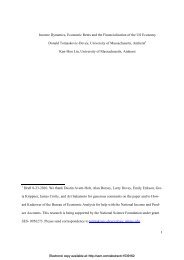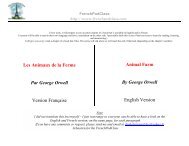Corporate governance and firm valuation
Corporate governance and firm valuation
Corporate governance and firm valuation
Create successful ePaper yourself
Turn your PDF publications into a flip-book with our unique Google optimized e-Paper software.
420 L.D. Brown, M.L. Caylor / Journal of Accounting <strong>and</strong> Public Policy 25 (2006) 409–434<br />
executive <strong>and</strong> director compensation category; the fourth in the ownership category;<br />
<strong>and</strong> the fifth in the board of directors’ category.<br />
5.2. BCF approach<br />
Our second approach mirrors the one undertaken by BCF when they evaluated<br />
the six factors underlying their entrenchment index. To assess each factor’s<br />
importance, BCF regress Tobin’s Q on the factor, G-Index minus the<br />
factor in question, <strong>and</strong> their control variables. We use a similar approach<br />
but rather than use the 24-factor G-Index minus the factor, we use the 51-factor<br />
Gov-Score index minus the factor (hereafter Gov-Rem50).<br />
Table 4 shows the nine factors that are significant <strong>and</strong> positive. Not surprisingly,<br />
Gov-Rem50 is significant in all nine regressions. 20 While not tabulated,<br />
the log of assets is significant in all nine regressions, the log of <strong>firm</strong> age is significant<br />
for two regressions (poison pill <strong>and</strong> board has outside advisors), <strong>and</strong><br />
the Delaware dummy is not significant in any regressions. Six factors are the<br />
same as those identified using the ALL approach. As we already delineated<br />
these six factors in Section 5.1, we do not repeat them here.<br />
Three factors are identified using the BCF procedure but not the ALL<br />
approach: (1) board guidelines are in each proxy statement; (2) option re-pricing<br />
is prohibited; <strong>and</strong> (3) board has outside advisors. ISS categorizes each of<br />
these three internal <strong>governance</strong> factors as board of directors, executive <strong>and</strong><br />
director compensation, <strong>and</strong> progressive practices, respectively. None of these<br />
factors has been linked heretofore to <strong>firm</strong> value.<br />
5.3. STEP approach<br />
Our third approach for determining individual ISS factors linked to <strong>firm</strong> <strong>valuation</strong><br />
is to use stepwise regression. 21 Table 5 results reveal that four of these six<br />
factors were also identified using the ALL <strong>and</strong> BCF approaches: (1) average<br />
options granted in the past three years as a percentage of basic shares outst<strong>and</strong>ing<br />
did not exceed 3%; (2) board members are elected annually (no staggered<br />
board); (3) company either has no poison pill or a pill that was shareholder<br />
approved; <strong>and</strong> (4) option re-pricing did not occur within the last three years.<br />
Two factors were identified by both the ALL <strong>and</strong> BCF approaches (but not<br />
by the STEP procedure): (1) directors are subject to stock ownership guide-<br />
20<br />
Failure to find Gov-Rem50 to be significant would indicate that a single factor is the sole driver<br />
of the relation between Gov-Score <strong>and</strong> <strong>firm</strong> <strong>valuation</strong>.<br />
21<br />
We use the stepwise selection in SAS, which is a variant of the forward-selection technique,<br />
where variables already in the model do not necessarily stay there. In order to stay in the model, a<br />
coefficient must be significant at the 10% two-tailed level. The stepwise approach allows the control<br />
variables to enter the model but only log of assets enters.







